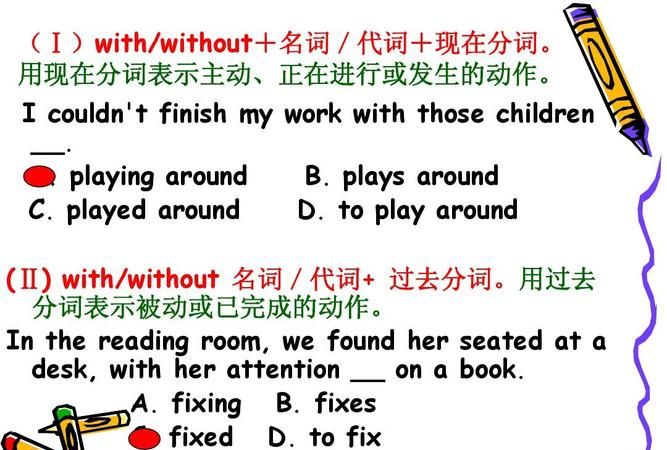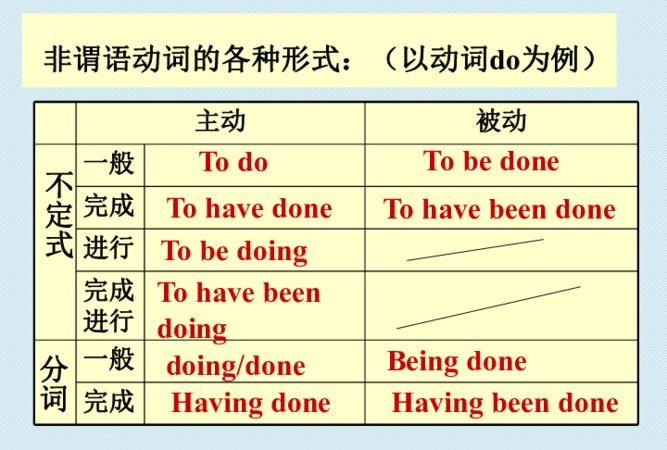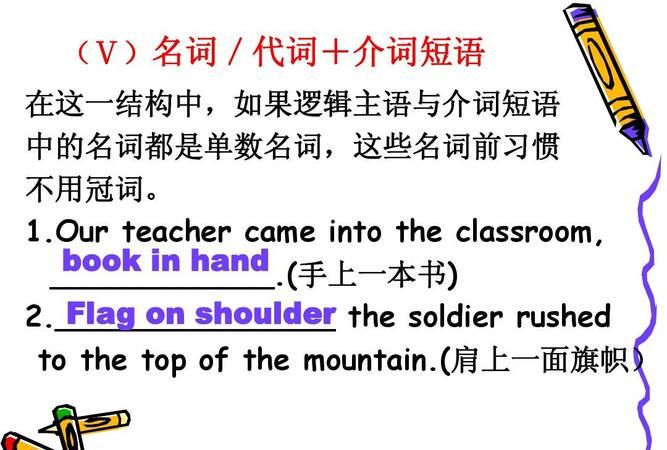一提到独立主格介词in 很多人都想知道,因此,小编觉得有必要给大家解读一下,独立主格是什么?有几种形式?各自的用法是什么?和英语中,独立主格结构是什么样子的?独立主格介词in 的内容,方便您深入了解英语中,一起深入了解。
独立主格介词in :什么是独立主格
独立主格结构
非及物动词就是cry,smile,sleep简单说就是这类你一个人就可以完成的动作,所以没有必要用被动语态.你说"我哭了",总不能转变成"我被哭了"吧?
第一个问题说来话长,不知道下面这些材料能不能帮到你~
独立主格结构本身不是句子,在句子中作状语,表示时间、原因、条件、伴随等。常见的独立主格结构有如下几种:
1. 名词/主格代词+现在分词。名词/主格代词与现在分词之间主谓关系。如:
The girl staring at him (= As the girl stared at him), he didn”t know what to say. 姑娘两眼望着他,他不知道说什么好。
Time permitting (= If time permits), we will go for an outing tomorrow. 如果时间允许的话,我们明天去郊游。
2. 名词/主格代词+过去分词。名词/主格代词与过去分词之间的动宾关系。如:
The problems solved (= As the problems were solved), the quality has been improved. 随着问题的解决,质量已经提高了。
Her glasses broken (= Because her glasses were broken), she couldn”t see the words on the blackboard. 由于眼镜摔坏了,她看不见黑板上的字。
3. 名词/主格代词+不定式。名词/主格代词与不定式之间是主谓关系,且强调的是一次具体性的动作。如:
He is going to make a model plane, some old parts to help. 借助于一些旧零件,他要做一个飞机模型。
They said good-bye to each other, one to go home, the other to go to the bookstore. 他们道别后,一个回了家,一个去了书店。
4. 名词/主格代词+形容词。如:
An air accident happened to the plane, nobody alive. 那架飞机遭遇了空难,无一人生还。
So many people absent, the meeting had to be called off. 这么多人缺席,会议不得不取消。
5. 名词/主格代词+副词。如:
He put on his sweater wrong side out. 他把毛衣穿反了。
The meeting over, they all went home. 会议一结束,他们就都回家了。
6. 名词/主格代词+介词短语。如:
The boy goes to the classroom, book in hand. 那男孩手里拿着书去教室。
Mary was sitting near the fire, her back towards the door. 玛丽靠近火炉坐着,背对着门。

独立主格介词in :英语中
独立主格结构
一. 结构和定义
“独立主格结构”是由逻辑主语(名词或代词)+ 逻辑谓语(分词、动词不定式、形容词、副词或介词短语)构成。它不是句子只作为一种固定结构独立存在,一般用逗号与主句分开,只在句中作状语。前置时相当于一个省略了的、且主语与主句主语不同的状语从句;后置时相当于一个并列句。例如:
1. 名词/代词(主格)+现在分词表示主动动作
Spring coming, it gets warmer and warmer. 春天来了,天气越来越暖和了。相当于:When spring comes,it gets warmer and warmer.
The rain having stopped, they went back to work. 雨停后,他就回去干活了。相当于:After the rain (had)stopped,they went back to work.
2. 名词/代词(主格)+过去分词表示被动动作
This done,he closed the door and went bed. 这事做完了,他就关门睡觉了。相当于:After this was done,he closed the door and went to bed.
He lay on his back in bed,his hands crossed under his
head.他头枕着双手仰面躺在床上。相当于:He lay on his back in bed,and his hands were
crossed under his head.
3.名词/代词(主格)+不定式表示将来动作
Here are the first two volumes,the third one to come out
next month. 这是头两卷,第三卷下个月出版。相当于:
Here are the first two volumes,and the
third one will come/is to come out next month.
The railway to be built soon,the houses along the line are being put down. 那条铁路马上就要建了,所以沿线的房屋正在拆除。相当于:Because the railway is (gong)to be built
soon,the houses along the line are
being put down.
We have divided the work, he to clean the windows and I to
sweep the floor. 我们进行了分工,他擦窗户,我扫地。We have divided the work: he is to clean the
windows and I am to sweep the floor.
4.名词/代词(主格)+副词、形容词、介词短语等表示状态
The farmhouse not far away from the village, we plannedd to walk along.既然农舍例村子不远,我们打算步行去。相当于:Since the farmhouse was not far away from the
village, we planned to walk
along.
My mother ill, I have to stay at home,looking after her. 因为妈妈病了,所以我只得留在家里照顾她。相当于:As my mother was ill, I have to stay at home,looking after her.
Hands in his pockets, he had a bad fall. 他当时两手插在口袋里,所以摔得很重。相当于:Becuase his hands were in his
pockets, he had a bad
fall.
The writer fought with his enimy, a pen his only
weapon. 作家和敌人战斗,唯一的武器就是笔。相当于:The writer fought with his enimy, and a pen was
his only weapon.
二. 功能与特点
“独立主格结构”在句中通常作状语,表示:时间、条件、原因、方式、让步、伴随等。表示时间、条件或原因等时一般放在句首相当于一个状语从句;表示方式或伴随时,通常放于句末,相当于一个并列句。例如:
1. 表示时间
The meeting (being)over(= After the meeting was over), all of us went home. 开完会后我们都回家了。
Her work done(= when her work was done), it began to
rain. 她干完活时,开始下雨了。
2.表示条件
Wheather permitting(=If weather permits), we will go
for a picnic this Saturday. 如果天气允许,本周六我们去野餐。
The condition(being)favorable(=As long as the condition is favorble),they will
continue the project. 只要条件有利,他们会继续那项工程的。
3.表示原因
There being no taxis(= Since there was no taxis), we
had to walk home. 没有出租车,我们只好步行回家。
We had to stay at home, the night being dark and cold(= because
the night was dark and cold). 夜又黑又冷,所以我们只得呆在家里。
4. 表示让步
Losses heavy(=Although losses were heavy), we recovered
production soon with their help.尽管损失惨重,但是在他们的帮助下我们很快就恢复了生产。
5.表示方式
She stood there, her eyes looking upward into the sky and her
hands crossed on her breast(=and her eyes were looking upward into the sky and
her hands were crossed on her breast).她站在那儿,双眼遥望天空双手交叉着放在胸前。
6.表示伴随情况
Every morning the old man walks in the park, his pet
dog following him along(=and his pet dog follows him along).
7..表示补充说明
We redoubled our efforts, each man working like
two(=and each man worked like two). 我们加倍努力,一个人干两个人的活。
三.容易混淆的两种形式
1. 介词with的复合结构
介词with加在独立主格结构,也是一种常见的状语形式,即:with +名词/代词(宾格)+分词、形容词、副词、不定式、介词短语,等。这种结构也可以作定语。例如:
With the guide leading us, we had no difficulty in finding the cave.有了向导带路,我们很容易就找到了那个洞穴。
The thief was brought in, with his hands tied behind his
back.小偷双手反捆在背后被带了进来。
He always sleeps in his room, with the light on and the
windows open.他在家睡觉时总是亮着灯、开着窗。
With the new machines to do the work, we can surely complete it ahead of time.有了这些新机器干活,我们一定会提前完成任务。
The woman with a scarf on her head is from the Middle
East.头上戴着头巾的那位妇女来自中东。
2. 名词/代词(宾格)+in+名词结构
名词/代词(宾格)+in+名词,且名词前不带任何成分,也不用复数形式。这也是独立主格结构的一种固定形式,又叫“三字式”独立主格结构或
“名介名”结构,它一般在句中只作伴随状语。例如:
He sat at the desk,pen in hand and
dumbfounded.他坐在课桌旁,手里拿着笔发呆。
I watched it carefully,tear in eye.我看着看着,热泪盈眶。
四.使用独立主格结构时要注意的几个问题
1.当状语从句的主语与主句的主语不同时,才可用独立主格结构取代状语从句,即:去掉连词后把从句的谓语改成非谓语形式。从句的谓语是主动语态用现在分词doing,被动语态用过去分词done,完成时用having(been)
done,被动进行用being done,将来时用to do/to be done,谓语是be动词,可以省去being。并列句改为伴随状语也是一样。例如:
If time permits(=Time permitting),we will drop in on
her.如果时间允许,我们会顺便去看她的。
Because the rice was not heated(=The rice not heated),she did
not eat it. 由于饭没热,她没吃。
After the teacher(had)left(=The teacher having left),we began
to clean the classroom. 老师走后,我们开始打扫教室。
Since the streets are being cleared(=The streets being
cleared), let’s go and help them.既然街道正在清理,咱们去帮帮忙吧。
After another airport is built here(= Another airport to be
built here),it will be more convenient for us to travel around. 另一个机场在这儿建成之后,我们出行就更方便了。。
Because the lights in the office were on(= The lights in the
office on/being on,), I phoned you to turn them off.因为当时办公室的灯都亮着,所以我打电话叫你去关灯。
2. 不能省略being的情形有下列几种情况。
(1). 独立主格结构的逻辑主语是代词。例如:
It being Sunday, we went to church.因为是星期天,我们去了做礼拜。
He being still out on business,we had to put off the
activity.由于他还在外出差,所以我们把活动推迟了。
(2).在There being+名词的结构中。例如:
There being no bus, we had to go home on foot.因为没有公共汽车,所以我们不得不步行回家。
There being too many film-goers,they haven’t bought the
tickets.由于看电影的人太多,所以他们还没买到票。
(3).被动进行时改为独立主格结构。例如:
The furniture being pained, don’t touch it please.家具在漆,请不要触摸。
My car being repaired in the garage,may I use
yours,Father?我的车还在修,用一下你的行吗,爸爸?
This road being repaired,you have to take another one. 这条路正在修,你得走令一条。
3.完成时改成的独立结构要用having done形式.例如:
They having done her work, it was dark.他们干完活后,天就黑了。
4.使用介词的问题:
在三字式独立主格结构中,当介词是in时,其前后的两个名词均不加任何成分(如物主代词或冠词),也不用复数。但 with 的复合结构不受此限制,例如:
A robber burst into the room, knife in hand. (
hand前不能加his;knife前不加a)。请比较:A robber burst
into the room, with a knife in his hand.)
再比较下面几个句子的不同译法:
“约翰先生进来了,手里拿着书”。
Mr. John came in,book in hand.
Mr. John came in,a book in his hand.
Mr. John came in,with a book in his hand.
Mr. John came in,holding a book in his hand.
Mr. John came in and (he)held a book in his hand.
来自网络。

独立主格介词in :什么是“独立主格”
(一): 独立主格结构的构成:
名词(代词)+现在分词、过去分词;
名词(代词)+形容词;
名词(代词)+副词;
名词(代词)+不定式;
名词(代词) +介词短语构成。
(二) 独立主格结构的特点:
1)独立主格结构的逻辑主语与句子的主语不同,它独立存在。
2)名词或代词与后面的分词,形容词,副词,不定 式,介词等是主谓关系。
3)独立主格结构一般有逗号与主句分开。
举例:
The test finished, we began our holiday.
= When the test was finished, we began our holiday.
考试结束了,我们开始放假。
The president assassinated, the whole country was in deep sorrow.
= After the president was assassinated, the whole country was in deep sorrow.
总统被谋杀了,举国上下沉浸在悲哀之中。
Weather permitting, we are going to visit you tomorrow.
如果天气允许,我们明天去看你。
This done, we went home.
工作完成后,我们才回家。
The meeting gone over, everyone tired to go home earlier.
会议结束后,每个人都想早点回家。
He came into the room, his ears red with cold.
他回到了房子里,耳朵冻坏了。
He came out of the library, a large book under his arm.
他夹着本厚书,走出了图书馆

独立主格介词in :独立主格用法讲解
独立主格
1独立主格结构的构成:名词(代词)+现在分词、过去分词;
名词(代词)+形容词;
名词(代词)+副词;
名词(代词)+不定式;
名词(代词) +介词短语构成。
独立主格结构的特点:
1)独立主格结构的逻辑主语与句子的主语不同,它独立存在。
2)名词或代词与后面的分词,形容词,副词,不定式,介词等是主谓关系。
3)独立主格结构一般有逗号与主句分开。
例如: The test finished, we began our holiday. = When the test was finished, we began our holiday. 考试结束了,我们开始放假。
The president assassinated, the whole country was in deep sorrow. = After the president was assassinated, the whole country was in deep sorrow. 总统被谋杀了,举国上下沉浸在悲哀之中。
Weather permitting, we are going to visit you tomorrow. 天气允许,我们明天去看你。
This done, we went home. 工作完成后,我们才回家。
The meeting gone over, everyone tired to go home earlier. 会议结束后,每个人都想早点回家。
He came into the room, his ears red with cold. 他回到了房子里,耳朵冻得红通通的。
He came out of the library, a large book under his arm. 他夹着本厚书,走出了图书馆
2 with的复合结构作独立主格
表示伴随情况时,既可用分词的独立结构,也可用with的复合结构:with +名词(代词)+现在分词/过去分词/形容词/副词/不定式/介词短语。例如:
He stood there, his hand raised. = He stood there, with his hand raise.他举手着站在那儿。
典型例题
The murderer was brought in, with his hands ___ behind his back。
A. being tied B. having tied C. to be tied D. tied
答案D. with +名词(代词)+分词+介词短语结构。当分词表示伴随状况时,其主语常常用with来引导。由于本句中名词"手"与分词"绑"是被动关系,因此用过去分词,选D.
注意:
1) 独立主格结构使用介词的问题: 当介词是in时,其前后的两个名词均不加任何成分(如物主代词或冠词),也不用复数。但 with 的复合结构不受此限制。例如:A robber burst into the room, knife in hand.(hand前不能加his)劫匪冲进房间,手里拿着刀。
2) 当表示人体部位的词做逻辑主语时,及物动词用现在分词,不及物动词用过去分词。例如:
He lay there, his teeth set, his hand clenched, his eyes looking straight up.
他躺在那儿,牙紧咬,双手握拳,两眼直勾勾看着上面。
典型例题:
Weather___, we”ll go out for a walk.
A permitted B permitting C permits D for permitting
答案B. 本题中没有连词,它不是复合句,也不是并列句。 句中使用了逗号,且we 小写,可知其不是两个简单句。能够这样使用的只有独立主格或with的复合结构。据此判断,本句中使用的是独立结构,其结构为:名词+分词。 由于permit在这里翻译为”天气允许”,表主动,应用现在分词,故选B。
如果不会判断独立结构作状语的形式,不妨将句子改为条件句,例如本句改为If weather permits, we”ll go out for a walk. 然后将if 去掉,再将谓语动词改为非谓语动词即可

以上就是关于独立主格介词in ,英语中的全部内容,以及独立主格介词in 的相关内容,希望能够帮到您。

